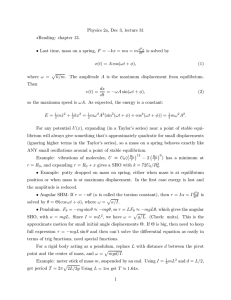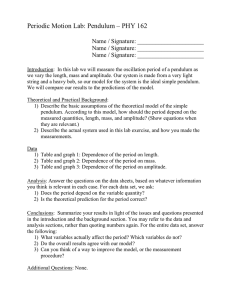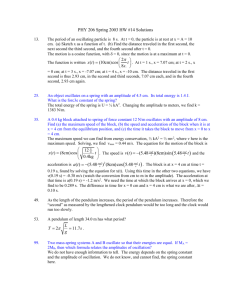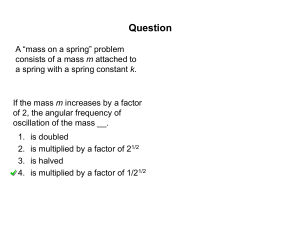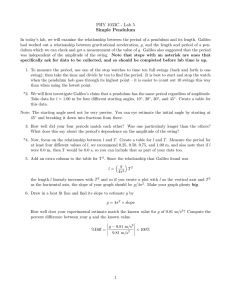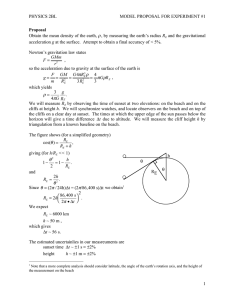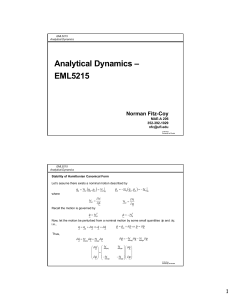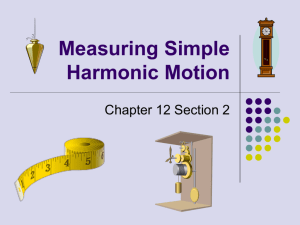Solutions Assignment 10 11.17*, 11.19, 11.27**, 11.32***
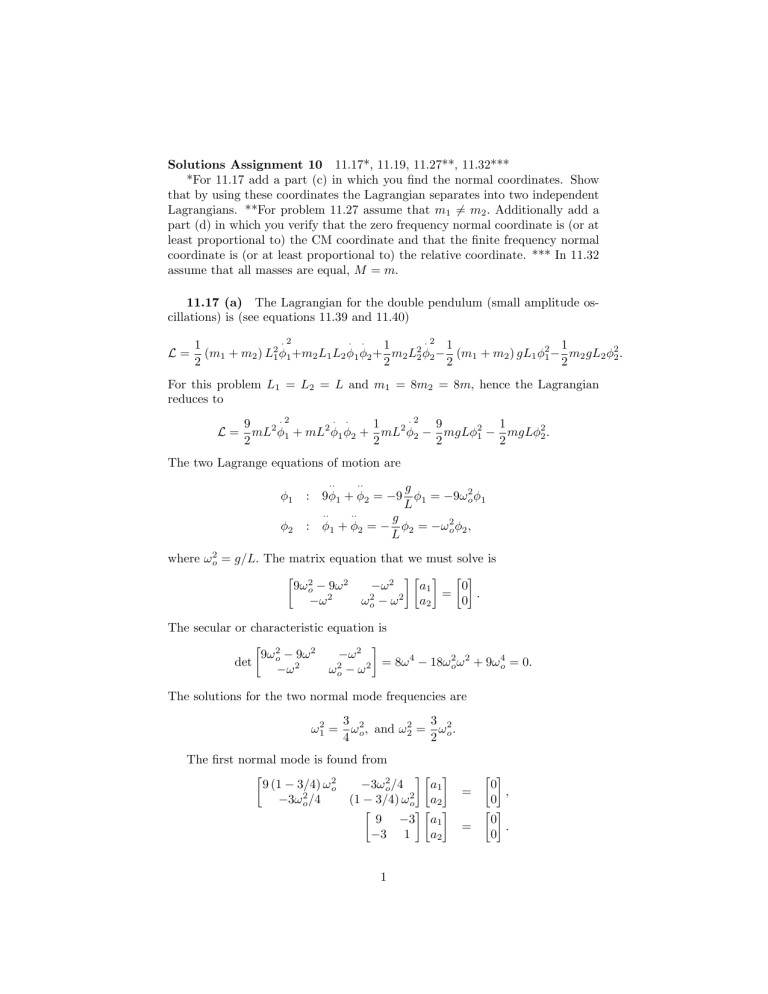
Solutions Assignment 10 11.17*, 11.19, 11.27**, 11.32***
*For 11.17 add a part (c) in which you …nd the normal coordinates. Show that by using these coordinates the Lagrangian separates into two independent
Lagrangians. **For problem 11.27 assume that m
1
= m
2
: Additionally add a part (d) in which you verify that the zero frequency normal coordinate is (or at least proportional to) the CM coordinate and that the …nite frequency normal coordinate is (or at least proportional to) the relative coordinate. *** In 11.32
assume that all masses are equal, M = m .
11.17 (a) The Lagrangian for the double pendulum (small amplitude oscillations) is (see equations 11.39 and 11.40)
L =
1
2
( m
1
+ m
2
) L
2
1
2
1
+ m
2
L
1
L
2 1 2
+
1
2 m
2
L
2
2
2
2
1
2
( m
1
+ m
2
) gL
1
2
1
For this problem L
1 reduces to
= L
2
= L and m
1
= 8 m
2
= 8 m; hence the Lagrangian
L =
9
2 mL
2
2
1
+ mL
2
1 2
+
1
2 mL
2
2
2
9
2 mgL
2
1
1
2 mgL
2
2
:
The two Lagrange equations of motion are
1
2 m
2 gL
2
2
2
:
1
2
:
: 9
1
1
+
+
2
2 g
= 9
L g
=
L
2
1
= 9 !
2 o 1
= !
2 o 2
; where !
2 o
= g=L: The matrix equation that we must solve is
9 !
2 o
!
2
9 !
2
!
2 o
!
2
!
2 a a
1
2
=
0
0
:
The secular or characteristic equation is det
9 !
2 o
!
2
9 !
2
!
2 o
!
2
!
2
= 8 !
4
18 !
2 o
!
The solutions for the two normal mode frequencies are
2
+ 9 !
4 o
= 0 :
!
2
1
=
3
4
!
2 o
; and !
2
2
=
3
2
!
2 o
:
The …rst normal mode is found from
9 (1 3 = 4) !
2 o
3 !
2 o
= 4
3 !
2 o
= 4
(1 3 = 4) !
2 o
9
3 1
3 a a a a
1
2
1
2
=
=
0
0
0
0
:
;
1
The solution is a
1
= a
2
= 3 : In this mode both pendulums oscillate in phase with the upper pendulum having an amplitude that is 1 = 3 that of the lower pendulum.
The second normal mode is found from
9 (1 3 = 2) !
2 o
3 !
2 o
= 2
9 = 2
3 = 2
3 !
2 o
= 2
(1 3 = 2) !
2 o
3
1
=
=
2
2 a a a a
1
2
1
2
=
=
0
0
0
0
:
;
The solution is a
1
= a
2
= 3 : In this mode both pendulums oscillate exactly out of phase with the upper pendulum again having an amplitude that is 1 = 3 that of the lower pendulum.
(b)
Given the initial conditions for this pendulum are
2
= 0 ; then the solutions are in the form
1
=
2
= and
1
=
1
2
( t )
( t )
= A
1
1
3 cos !
1 t + A
2
1
3 cos !
2 t:
This results in
1
(0) =
2
(0) = 0 : The additional initial condition results in
1
(0)
2
(0)
= A
1
1
3
+ A
2
Solving for A
1 and A
2 we …nd
1
3
=
1
1
:
A
1
+ A
2
A
1
A
2
=
= = 3 or
A
1
= 2 = 3 and A
2
= = 3 :
The expression for the solution is
1
( t )
2
( t )
=
2
3
1
3 cos p
3 g= 4 Lt +
3
1
3 cos p
3 g= 2 Lt:
Since the ratio of the normal mode frequencies is motion is NOT periodic.
p
2 which is irrational, the
(c) The normal mode coordinates satisfy
= 1
2
=
1
1 = 3
1
+
2
1 = 3
1 so that
1
= (
1
+
2
) = 3 and
2
=
1 2
:
2
In these coordinates the Lagrangian is given by
L
L
=
=
2
9
2 mL
2
9
2 mgL
2
(
4
3 mL
2
1
1
+
9
2
+ mL
2 1
+
3
1
+
9 mgL
2
)
2
2
1
+
1
2 mgL (
2
2
3 mL
2
2
1
2
2 mgL
1
)
2
2
2
;
2
+
1
2 mL
2
= L
1
+ L
2
:
This separates immediately and for a general solution we …nd
1
= A
1 cos p
3 g= 4 Lt
1
;
2
= A
2 cos p
3 g= 2 Lt
1
2
:
2
2
11.19(a) The x; y coordinates of the pendulum bob are x bob
= x + L sin ; y bob
= L cos :
The velocities are x bob
= x + L cos ; y bob
= L sin :
Squaring the velocities and adding yields v
2 bob
= x
2
+ 2 L cos x + L
2
2
:
For small amplitude oscillations this becomes v
2 bob
= x
2
+ 2 L x + L
2
2
The Lagrangian for this system is
L
L
=
=
1
2
1
2
( M + m ) x
2
+ 2 M L x + M L
2
2
( M + m ) x
2
+ 2 M L x + M L
2
2
1
2
1
2 kx kx
2
2
+ M gL cos
1
2
M gL
2
:
The two equations of motion are x : ( M + m ) x + M L = kx:
: M x + M L = M g :
3
(b) Assuming units in which that m = M = L = g = 1 and k = 2 ; the matrix equation we must solve is
2 2 !
2
!
2
!
2
1 !
2 a a
1
2
=
0
0
:
The secular or characteristic equation that results is det
2 2 !
2
!
2
!
2
1 !
2
= !
4
4 !
2
+ 2 = 0 ; with solutions
!
2
1
= 2 p
2
The solution for !
1
2 2 2
2 p
2 p
2 p
2 2 p
2 1 is found from p
2
1 2 p
2 p
2
2 +
1 + p
2 p
2 p
2 a
1 a
2 a
1 a
2 and
=
=
!
2
2
0
0
= 2 + p
2 :
2 + p
2 + 2 p
2
2 2 +
1 + p
2 p
2
!
p
2 a
1
= a
2 a
1 a
2
=
0
0
2 2 2 +
2 + p p
2
2 p
2 2 +
2 1 +
2 +
1 2 + p
2 2 p
2 1 p p
2 p
2 p
2 a a a a
1
2
1
2
=
0
0
!
p
2 a
1
= a
2 p smaller than the amplitude of the pendulum bob by a factor of
The solution for !
2 is found from
= p
2 2 p
2 2
2 2
1 p
2 p
2
2 : a
1 a
2
=
0
0 of the cart smaller than the amplitude of the pendulum bob by a factor of 2 :
11.27 (a) The Lagrangian for this system is
L =
1
2 m
1 x
2
1
The equations of motion are
+
1
2 m
2 x
2
2
1
2 k ( x
1 x
2
)
2
: m
1 x
1 m
2 x
2
= kx
1
+ kx
2
= kx
1 kx
2
;
The matrix equation that we must solve is k !
2 m
1 k k k !
2 m
2 a a
1
2
=
0
0
:
4
The resulting secular equation is det k !
2 m
1 k k !
k
2 m
2
= m
1 m
2
!
4
( m
1
+ m
2 with solutions
!
2
1
= 0 and !
2
2
=
( m
1
+ m
2
) k m
1 m
2
= k= ; where is the reduced mass of this system.
) k!
2
= 0 ;
(b) For the nonzero frequency the matrix equation becomes k kM=m k
2 k k kM=m
1 a a
1
2
= m
1 k=m k
2 k m
2 k=m
1 a a
1
2
=
0
0
; with solution m
1 a
1
= m
2 a
2
!
m
1 a
1
+ m
2 a
2
= 0 :
In this mode as one mass moves relative to the center of mass the other moves in the opposite direction with an amplitude that keeps the center of mass …xed
(or at least moving uniformly)
(c) At zero frequency the equation of motion reduces to no restoring force which implies uniform translation. For the zero frequency we …nd k k k k a
1 a
2
=
0
0
; with solution a
1
= a
2
:
Both masses travel with equal amplitude (this keeps the center of mass moving at a uniform velocity).
(d) The general solution is x = A
1 m
2 m
1 cos ( !
1 t and the normal coordinates are x = x
1 x
2
=
2
1
) +
1
1
( vt + x o m
2 m
1
+
1
1
1
)
To solve for the normal coordinates we invert the algebraic relations x
1 x
2
= m
2 2
+
= m
1 2
+
1
1
:
5
The normal coordinate for !
2
1
= 0 is
1
= det m
2 m
1 m
2
+ m
1 x
1 x
2
= m
2 x
2
+ m
1 x
1 m
2
+ m
1
= X where X is the center of mass of the two masses. The normal coordinate for
!
2
2
= k= is
2
= det m
2 x
1 x
2
+ m
1
1
1
= x m
1
2
+ x m
2
1
= x=M where x is the relative coordinate.
11.32 (a) The Lagrangian for this system is
L =
1
2 m x
2
1
+ x
2
2
+ x
2
3
1
2 k ( x
2 x
1
)
2
The three equations of motion are
1
2 k ( x
3 x
2
)
2 x
1 x
2 x
3
: mx
1
= k ( x
1
: mx
2
= k ( x
2
: mx
3
= k ( x
3 x
2
) = kx
1
+ kx
2 x
1
) k ( x
2 x
3
) = kx
1 x
2
) = kx
3
+ kx
2
:
2 kx
2
+ kx
3
The resulting matrix equation is
2
4 k m!
k
2
0 k
2 k m!
k
2
3
0 k k m!
2
5
2
4 a a
1
2
3
5
= a
3
2
4
0
0
3
5
:
0
The secular equation is det
2
4 k m!
k
2
2 k k m!
2
0 k
!
2
!
4
0 k k m!
2
4 ( k=m ) !
2
+ 3 ( k=m )
2
3
5
= m
3
!
6
= !
2
!
2
+ 4 km
2
!
4 k=m !
2
3 k
2 m!
2
= 0 ;
3 k=m = 0 :
Clearly one of the solutions occurs at !
2 = 0 :
(b) The normal mode solution for !
2
4
0 k k
3 k 0 k
5
2
= k=m is found from
2
4 a a
1
2
3
5
=
2
4
0
0
3
5
:
0 k 0 a
3
0
The solutions are a
2
= 0 ; and a
1
= a
3
: In this mode the center mass remains stationary while the outside masses oscillate exactly out of phase with equal amplitudes. Clearly this explains why !
2
= k=m:
6
The normal mode solution for !
2
2
= 3 k=m is found from
4
2 k k
0 k k
0 k k 2 k
3
5
2
4 a a
1
2
3
5
= a
3
2
4
0
0
3
5
:
0
The solutions are a
2
= 0 ; and a
1
= a
3
: In this mode the center mass remains stationary while the outside mass oscillate exactly out of phase with equal amplitudes. Clearly this explains why !
2 = k=m: The solution is a
2
= 2 a
1
= 2 a
3
:
The two outer mass oscillate in phase with equal amplitudes while the center mass oscillates exactly out of phase with twice the amplitude of the outer masses. This is consistent with !
2 = 3 k=m:
(c) The normal mode solution for !
2 = 0 is found from
2
4 k
3 k 2 k 0 k k
5
0 k k
2
4 a a
1
2
3
5
= a
3
2
4
0
0
3
5
:
0
The solution is simply a
1
= a masses which explains why !
2
2
= a
3
: This is a uniform translation of the three
= 0 :
7
